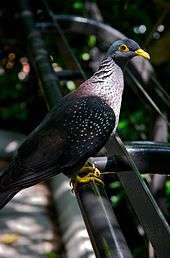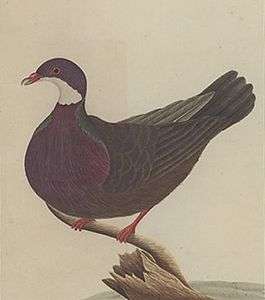Columba (genus)
The large bird genus Columba comprises a group of medium to large stout-bodied pigeons, often referred to as the typical pigeons. The terms "dove" and "pigeon" are used indiscriminately for smaller and larger Columbidae, respectively. Columba species – at least those of Columba sensu stricto – are generally termed "pigeons", and in many cases wood-pigeons. The species commonly referred to just as "the pigeon" is the feral pigeon (C. livia domestica). It is derived from the rock dove (C. livia), which also has given rise to the majority of domesticated pigeon breeds, such as the racing pigeon and the fantail pigeon. Meanwhile, "wood pigeon" by itself usually means the common wood pigeon (C. palumbus).
| Columba | |
|---|---|
.jpg) | |
| Common wood pigeon (C. palumbus) in Taormina, Sicily | |
| Scientific classification | |
| Kingdom: | Animalia |
| Phylum: | Chordata |
| Class: | Aves |
| Order: | Columbiformes |
| Family: | Columbidae |
| Subfamily: | Columbinae |
| Genus: | Columba Linnaeus, 1758 |
| Diversity | |
| 33–35 species | |
| Synonyms | |
|
Aplopelia Bonaparte, 1855 (but see text) | |
This genus as understood today is native to the Old World, but some – notably the domestic and feral rock pigeon – have been introduced outside their natural range, for example in the Americas.
Etymology
The term columba comes from the Latin columba, "a dove",[1] the feminine form of columbus, "a male dove",[2] itself the latinisation of the Greek κόλυμβος (kolumbos), "diver",[3] which derives from the verb κολυμβάω (kolumbaō), "to dive, plunge headlong, swim".[4] The feminine form of kolumbos, κολυμβίς (kolumbis), "diver",[5] was the name applied by Aristophanes and others to the common rock pigeons of Greece, because of the "swimming" motion made by their wings when flying.[6]
Taxonomy
The genus Columba was introduced by the Swedish naturalist Carl Linnaeus in 1758 in the tenth edition of his Systema Naturae.[7] The type species was designated as the stock dove (Columba oenas) by Irish zoologist Nicholas Aylward Vigors in 1825.[8]
The American pigeons formerly in Columba are now split off as a separate genus Patagioenas again. That the American radiation constitutes a distinct lineage is borne out by molecular evidence; in fact, the Patagioenas "pigeons" are basal to the split between the Columba "pigeons" and the Streptopelia "doves". The typical pigeons together with Streptopelia and the minor Nesoenas and Stigmatopelia lineages constitute the dominant evolutionary radiation of Columbidae in temperate Eurasia, though they also occur in tropical regions. The taxonomic status of some African pigeons presently placed here is in need of further study; they are smaller than the usual Columba (and hence often called "doves"), and differ in some other aspects. They might be separable as genus Aplopelia. That notwithstanding, the lineage of the typical pigeons probably diverged from its closest relatives in the Late Miocene, perhaps some 7-8 million years ago (Ma).[9][10]
Species



There are 35 species recognised in the genus of which two are extinct:[11]
- Rock dove, Columba livia
- Hill pigeon, Columba rupestris
- Snow pigeon, Columba leuconota
- Speckled pigeon, Columba guinea
- White-collared pigeon, Columba albitorques
- Stock dove, Columba oenas
- Yellow-eyed pigeon, Columba eversmanni
- Somali pigeon, Columba oliviae
- Common wood pigeon or wood pigeon, Columba palumbus
- Trocaz pigeon, Columba trocaz
- Bolle's pigeon, Columba bollii
- Laurel pigeon, Columba junoniae
- Afep pigeon, Columba unicincta
- African olive pigeon, Columba arquatrix
- Cameroon olive pigeon, Columba sjostedti
- São Tomé olive pigeon, Columba thomensis
- Comoros olive pigeon, Columba polleni
- Speckled wood pigeon, Columba hodgsonii
- White-naped pigeon, Columba albinucha
- Ashy wood pigeon, Columba pulchricollis
- Nilgiri wood pigeon, Columba elphinstonii
- Sri Lanka wood pigeon, Columba torringtoniae
- Pale-capped pigeon, Columba punicea
- Silvery pigeon, Columba argentina – (thought to be extinct, rediscovered in 2008)
- Andaman wood pigeon, Columba palumboides
- Japanese wood pigeon, Columba janthina
- † Bonin wood pigeon, Columba versicolor – extinct (c. 1890)
- † Ryukyu wood pigeon, Columba jouyi – extinct (late 1930s)
- Metallic pigeon or white-throated pigeon, Columba vitiensis
- White-headed pigeon, Columba leucomela
- Yellow-legged pigeon, Columba pallidiceps
- Eastern bronze-naped pigeon, Columba delegorguei
- Western bronze-naped pigeon, Columba iriditorques
- Island bronze-naped pigeon, Columba malherbii
- Lemon dove, Columba larvata – sometimes placed in Aplopelia
A fossil species, C. omnisanctorum, was described from the Early Pliocene (5.3-3.6 Ma) of the Gargano Peninsula and surroundings, Italy. A supposed "falcon" fossil from nearby contemporary and Middle Pliocene (3.6-2.6 Ma) sites may either be of the same species or another pigeon; the name Columba pisana would apply for it or (if conspecific) for both. C. melitensis is a fossil pigeon from the Late Pleistocene of Malta. Only known from a coracoid described by Richard Lydekker in 1891, whether it is indeed distinct from the living species and not just a paleosubspecies needs to be studied, given its late age. Indeterminate remains of a Columba were also found in Late Pliocene/Early Pleistocene (ELMMZ MN 17) deposits at Varshets (Bulgaria) and Šandalja (Croatia).[12]
Another prehistoric pigeon, C. congi, was described from Early Pleistocene remains found in the famous Zhoukoudian caves in China. This, too, needs to be studied regarding whether it is not just an ancestral population of a still-living species. An extinct pigeon, the Mauritian wood pigeon (Columba thiriouxi), was described in 2011. The validity of the species has been challenged and it is not generally recognised. The holotype is a right tarsometatarsus collected in 1910.[13]
References
- columba, Charlton T. Lewis, Charles Short, A Latin Dictionary, on Perseus
- columbus, Henry George Liddell, Robert Scott, A Greek-English Lexicon, on Perseus
- κόλυμβος, Henry George Liddell, Robert Scott, A Greek-English Lexicon, on Perseus
- κολυμβάω, Henry George Liddell, Robert Scott, A Greek-English Lexicon, on Perseus
- κολυμβίς, Henry George Liddell, Robert Scott, A Greek-English Lexicon, on Perseus
- Aristophanes, Birds, 304, on Perseus
- Linnaeus, Carl (1758). Systema Naturae per regna tria naturae, secundum classes, ordines, genera, species, cum characteribus, differentiis, synonymis, locis (in Latin). Volume 1 (10th ed.). Holmiae (Stockholm): Laurentii Salvii. p. 162.
- Vigors, Nicholas Aylward (1825). "Observations on the natural affinities that connect the orders and families of birds". Transactions of the Linnean Society of London. 14 (3): 395–517 [481].
- Johnson, K.P.; De Kort, S.; Dinwoodey, K.; Mateman, A.C.; Ten Cate, C.; Lessells, C.M.; Clayton, D.H. (2001). "A molecular phylogeny of the dove genera Streptopelia and Columba". Auk. 118 (4): 874–887. doi:10.1642/0004-8038(2001)118[0874:AMPOTD]2.0.CO;2.
- Cheke, Anthony S. (2005). "Naming segregates from the Columba–Streptopelia pigeons following DNA studies on phylogeny". Bulletin of the British Ornithologists' Club. 125 (4): 293–295.
- Gill, Frank; Donsker, David; Rasmussen, Pamela, eds. (2020). "Pigeons". IOC World Bird List Version 10.1. International Ornithologists' Union. Retrieved 1 March 2020.
- Mlíkovský (2002): pp.221-222.
- del Hoyo, J.; Elliott, A.; Sargatal, J.; Christie, D.A.; de Juana, E., eds. (2020). "Mauritius Woodpigeon (Columba thiriouxi)". Handbook of the Birds of the World Alive. Lynx Edicions. Retrieved 1 March 2020.
Sources
- Mlíkovský, Jirí (2002): Cenozoic Birds of the World, Part 1: Europe. Ninox Press, Prague. ISBN 80-901105-3-8 PDF fulltext